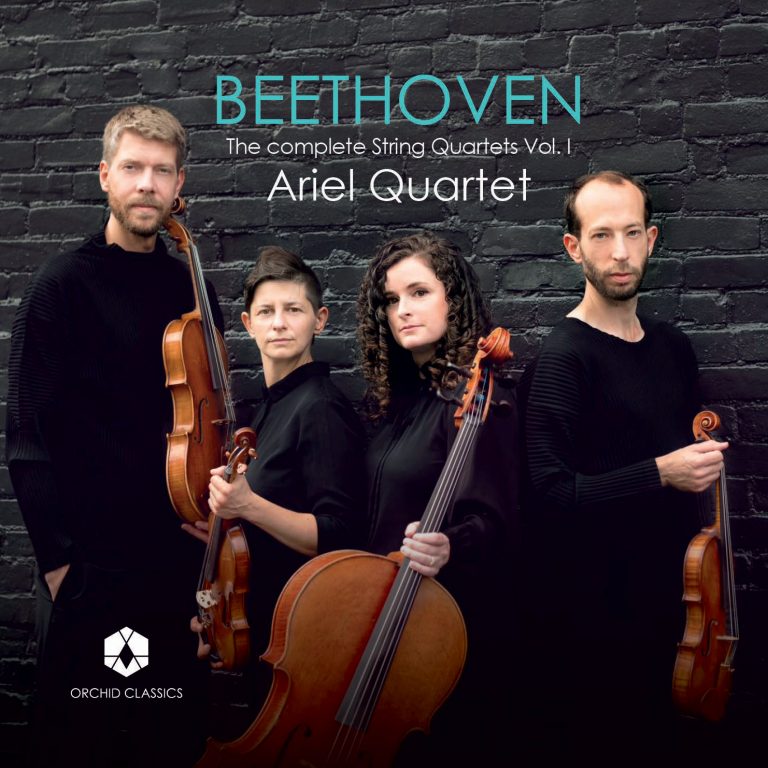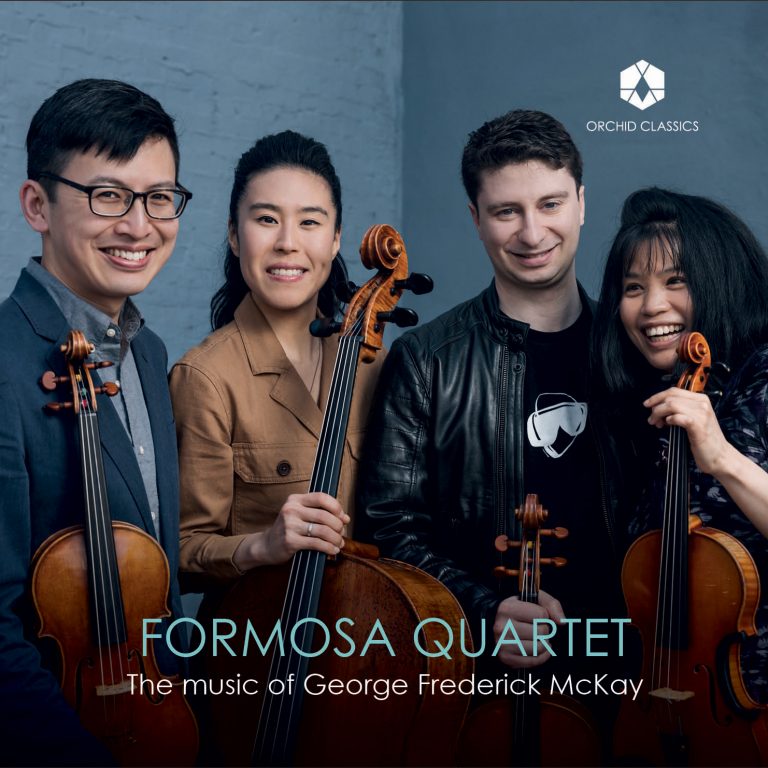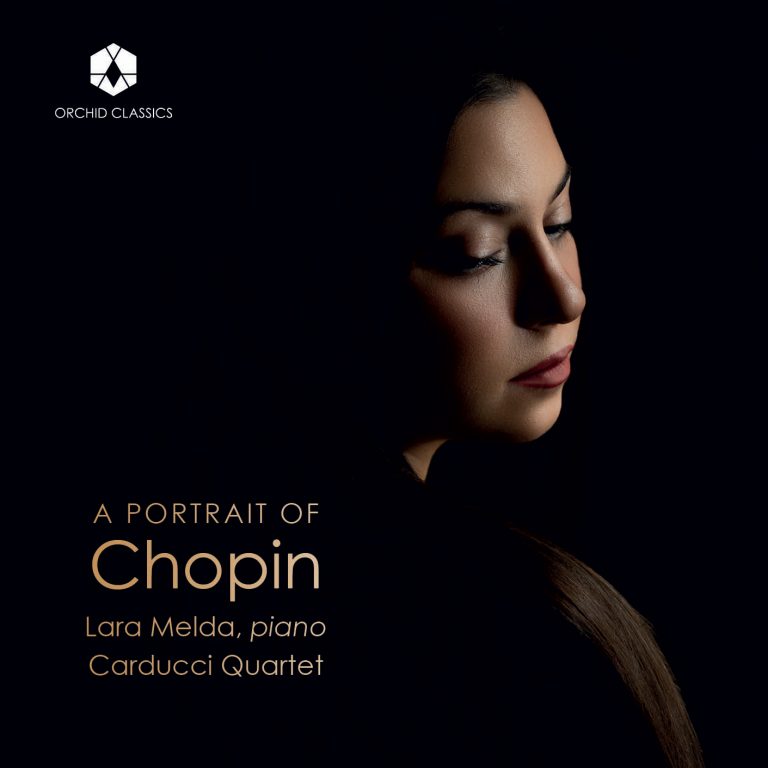Artist Led, Creatively Driven

BEETHOVEN STRING QUARTETS – Volume 2
Ariel Quartet
Release Date: November 7th 2025
ORC100403
BEETHOVEN STRING QUARTETS
Disc 1
Ludwig van Beethoven (1770-1827)
String Quartet No.7 in F major, Op.59 No.1
1. Allegro
2. Allegretto vivace e sempre scherzando
3. Adagio molto e mesto
4. Thème Russe: Allegro
String Quartet No.9 in C major, Op.59 No.3
5. Introduzione: Andante con moto – Allegro vivace
6. Andante con moto quasi allegretto
7. Menuetto: Grazioso
8. Allegro molto
Disc 2
Ludwig van Beethoven (1770-1827) String Quartet No.8 in E minor, Op.59 No.2
1. Allegro
2. Molto adagio
3. Allegretto
4. Presto
Disc 3
Ludwig van Beethoven (1770-1827)
String Quartet No.10 in E-flat major, Op.74
1. Poco adagio – Allegro
2. Adagio ma non troppo
3. Presto
4. Allegretto con variazioni
String Quartet No.11 in F minor, Op.95, ‘Quartetto serioso’
5. Allegro con brio
6. Allegretto ma non troppo
7. Allegro assai vivace ma serioso
8. Larghetto espressivo – Allegretto agitato – Allegro
Alexandra Kazovsky, violin
Gershon Gerchikov, violin
Jan Grüning, viola
Amit Even-Tov, cello
“[…] I must despise the world which does not know that music
is a higher revelation than all wisdom and philosophy.
It is the wine which inspires one to new creative processes,
and I am the Bacchus who presses out this glorious wine for
mankind and makes them spiritually drunk […].
And I have no misgivings about my music – no evil fate can befall it;
he to whom it makes itself intelligible must become free
from all the miseries in which others drag themselves about.”
– Ludwig van Beethoven (1806-1810), as reported by Bettina Brentano in a letter to Goethe (May 28, 1810), published in Goethe’s Correspondence with a Child (1835).
Our View
Beethoven’s string quartets have been covered from every angle, so rather than offering a theoretical analysis (fascinating as it is!) we want to share a little about what makes us come back to this music for over 25 years now, how we approach it as interpreters and why we decided to record it. If you are interested in understanding the intricacies of the music in greater detail, we recommend starting with Joseph Kerman’s ‘The Beethoven Quartets’ and going from there.
In the previous booklet accompanying the Op. 18 release, we concluded that this early set already reveals Beethoven’s distinct compositional language, marked by extraordinary emotional depth. Barely six years later, Beethoven composed his Op. 59 quartets, dedicated to Count Razumovsky—three works that serve both as the gateway to his middle period and the most substantial contribution within it. The warm and elegant Op. 74, together with the short and stormy Op. 95, complete Beethoven’s string quartet output from the so-called ‘heroic’ period – often regarded as a kind of prelude to the Romantic era.
In many ways, the Op. 59 quartets represent the most significant departure in the entire canon: the formal and structural norms established by Haydn and Mozart are cast aside, a new harmonic boldness is relentlessly pursued, and the textural as well as instrumental complexity is expanded as all four instruments engage in contrapuntal interplay and equal dialogue. The slow movements – such as the hymn-like Adagio of Op. 59 No. 2 – convey a spiritual profundity rarely encountered in Classical-era quartets. At the same time, Beethoven’s decision to incorporate Russian folk tunes at Razumovsky’s request marks a shift toward the organic integration of folk elements into serious chamber music, a feature entirely absent in Op. 18.
The heroic period is marked by a notable affinity for the key of E-flat major, with works such as the Eroica Symphony (Op. 55), the Emperor Concerto (Op. 73), the Piano Trio (Op. 70 No. 2) – and the ‘Harp’ Quartet (Op. 74). For Beethoven, this key came to symbolize heroism, nobility, and – especially in later works – transcendence. Having earned its nickname through the unusual use of pizzicato in the first movement, Op. 74 presents a majestic yet lyrical character, while offering a more intimate and refined atmosphere than its symphonic E-flat major counterparts. Once again, a gorgeously flowing slow movement forms the heart of the work, while the final movement features the second of only four variation movements Beethoven composed in the string quartet genre.
Op. 95 – typically referred to as the Serioso – is the most intense and compact of Beethoven’s quartets, marked by ferocity, volatility, and radical concision. Likely conceived as a compositional experiment, it serves as a turning point by bridging the heroic middle period and the introspective late period. In an 1816 letter, Beethoven wrote to George Smart that this work was ‘written for a small circle of connoisseurs and is never to be performed in public.’ This sentiment foreshadows the deeply personal and transcendent nature of his late quartets, which would go on to challenge the boundaries of musical form and expression.
A memorable milestone in our personal journey with Beethoven was a concert at Frankfurt’s Kaisersaal during the 1999/2000 season, where we performed all three Razumovsky Quartets in a single evening. At sixteen, we approached the challenge with youthful excitement, and through countless hours in rehearsal we began to understand the depth and demands of this music – gradually developing not only the stamina, but the artistic maturity required to bring over two hours of this intricate music to life. Youthful enthusiasm (let’s be honest: fearlessness) alone allowed us to commit to the repertoire for this important concert without hesitation – and luckily, all went well. In hindsight, preparing this music for increasingly demanding opportunities played a crucial role in forging a confident and lasting relationship with this extraordinary canon.
As interpreters, we love diving deeply into the music’s details and we leave no theoretical and contextual stone unturned. At the same time, we make sure to maintain our intuitive approach to the music: every work we learn is first sight-read without preparation, unlocking our purest emotional reactions to the music. These feelings are then carefully preserved, allowing us to channel them when all the technical work of putting things where they belong is done. The next stage is when the magic truly happens, and we feel lucky to have been experiencing this over and over since 1998: when the music meets the energy of the audience it starts to develop a life of its own, making each performance a once-in-a-lifetime event. This connection transforms both the music and ourselves, and it’s this immediacy and expressivity we aimed to capture in our recording.
Our decision to record this cycle is meant as a testament to our belief in the enduring relevance of this incredible music. While we deeply admire the many renditions already available, we feel that this capture offers a new approach both in interpretation and in sound – thanks to Jesse Lewis, his remarkable ear and his possibly even more remarkable patience – and it is our hope that listening to it will take you straight to the heart of this music’s expressivity and communicative depth.
Our Story
A happy accident kickstarted our group in 1998, when we were 13 years old, attending a school for music and dance. Amidst stretching ballerinas and improvising jazz pianists, we were simply assigned to play together. Our teacher spoon-fed us repertoire just beyond our ability, knowing we were about to discover the addictive magic of playing string quartets. We spent our teenage years rehearsing in the school attic, immersing ourselves in the richness of the string quartet repertoire while learning to navigate both the music and our evolving relationships. Balancing a budding concert career with high school life was both challenging and rewarding, often providing excellent excuses to skip class. This lifestyle juxtaposition was on full display when we showed up to the prize-announcement ceremony of the 2003 Franz Schubert and Modern Music Competition in Graz, wearing pajamas, ready to cheer on the prize winners – only to discover we were to be awarded the first prize ourselves…
Today, 27 years in and with three founding members still on board, our mission is to breathe life into the bread and butter of the string quartet repertoire while shining a spotlight on the compelling music of our time. This commitment led us to perform the complete Beethoven cycle before any of us turned 30, while also expanding the repertoire through commissions by established composers such as Mohammed Fairouz, Matan Porat or John Harbison. The joy of sharing the music we love with audiences in the most direct way remains the essence of our experience as musicians – it is the “glue” that has kept us together for more than half our lives. We were fortunate to have had inspiring mentors, including the members of the Cleveland Quartet, Walter Levin of the LaSalle Quartet, and the Amadeus Quartet. Over the past 12 years, succeeding the LaSalle Quartet as Quartet-in-Residence at the Cincinnati College-Conservatory of Music (CCM) has become a deeply fulfilling part of our lives. Sharing the experience we’ve gained onstage, we maintain individual studios, mentor young ensembles, and are particularly excited about the recent revival of the renowned graduate string quartet residency program.
Our unusual journey has been fundamental in shaping who we are. Beyond the demands of our shared professional path, we have walked together as friends who have truly become family. From late-night debates about tempo and sight-reading marathons to raising our children alongside one another while balancing an international concert career, we have shared every stage of life. This closeness has created a deep and unique bond that continues to shape our identity, both on stage and beyond.









